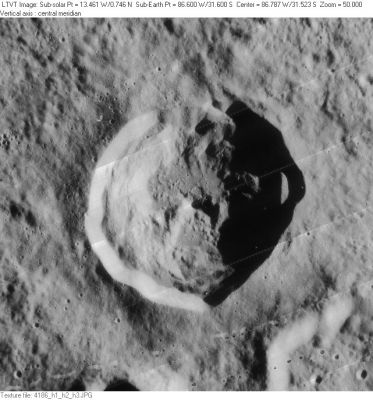Wright
Contents
Wright (of the pair Wright-Shaler)
|
Lat: 31.6°S, Long: 86.7°W, Diam: 38.73 km, Depth: 4.03 km, Rükl: 61 |
LO-IV-186H
Wright in the central section of the image, its companion Shaler in the lower right corner.
Images
LPOD Photo Gallery Lunar Orbiter Images
Maps
(LAC zone 91D4) USGS Digital Atlas PDF
Description
Wikipedia
Additional Information
- IAU page: Wright
- Depth data from Kurt Fisher database
- Westfall, 2000: 4.03 km
- TSI = 30, CPI = 15, FI = 20; MI =65 Smith and Sanchez, 1973
Nomenclature
- This name was originally proposed by Wilkins and Moore for a crater near Licetus but it was not accepted by IAU. It was shifted to a different (previously unnamed) crater in Rectified Lunar Atlas(1963) and approved by IAU in 1964 (IAU Transactions XIIB). The 1964 name apparently honored F. E. Wright. In Menzel, 1971, the IAU added two more honorees, so this crater currently commemorates three different men:
- Frederick Eugene Wright; American petrologist and astronomer (1877-1953). F. E. Wright was co-author of a major 1963 summary: "The Lunar Surface: Introduction" in The Moon, Meteorites and Comets (Edited by Middlehurst and GP Kuiper). F.E. Wright also was responsible for creating one of the most remarkable - and rare - lunar globes ever. Photographic emulsions were deposited on globes and then telescopic images were projected onto the globes. Some globes were made of glass and had light bulbs within - apparently, they "beautifully and realistically simulate the Moon." - tychocrater Jul 26, 2007 As Chairman of the Carnegie Institution of Washington's "Committee on the Study of Physical Features of the Surface of the Moon" from 1925-1940 he was widely regarded as the preeminent lunar scientist of his day; although apparently few, if any, of the ambitious projects announced in the Carnegie Institution Yearbooks ever reached completion (Both, 1961, p. 34).
- Thomas Wright; British philosopher (1711-1786). Thomas Wright included a map of the Moon in his 1750 book. His explanation of it begins on page 23.
- William Hammond Wright (November 4, 1871 - May 16, 1959) was an American astronomer. He is most famous for his work on radial velocity of stars in our galaxy, and his work with a spectrograph he designed himself. He obtained spectra of novas and nebulae. In 1924 he made photographic observations of Mars in multiple wave lengths. From these pictures he concluded that its atmosphere was about 60 miles (100 km) deep. (portrait)
- Although there's no crater (or craters) on the moon for Orville and Wilbur Wright (pioneers of aviation), the couple of then-unnamed craters now officially known as Kiess and Widmannstatten, at the south edge of Mare Smythii, were labeled the Wright Brothers on the map supplied to the Apollo 17 Command Module Pilot for use in describing his visual observations on Revolution 62. - DannyCaes Aug 19, 2010
LPOD Articles
Bibliography
- Alter, Dinsmore; Roques, Paul E. 1955. The Limb of the Moon. Publications of the Astronomical Society of the Pacific, Vol. 67, No. 397, p. 246 (with Plates 15, 16, 17 and 18) -- describes construction and use of globes "made at Mount Wilson by Dr. F. E. Wright with the assistance of his son, Dr. F. H. Wright"
- Kiess and Widmannstätten as the Wright brothers: NASA SP-330 Figure 28-9, page 28-12.
Named Featues -- Prev: Wreck -- Next: Wróblewski
